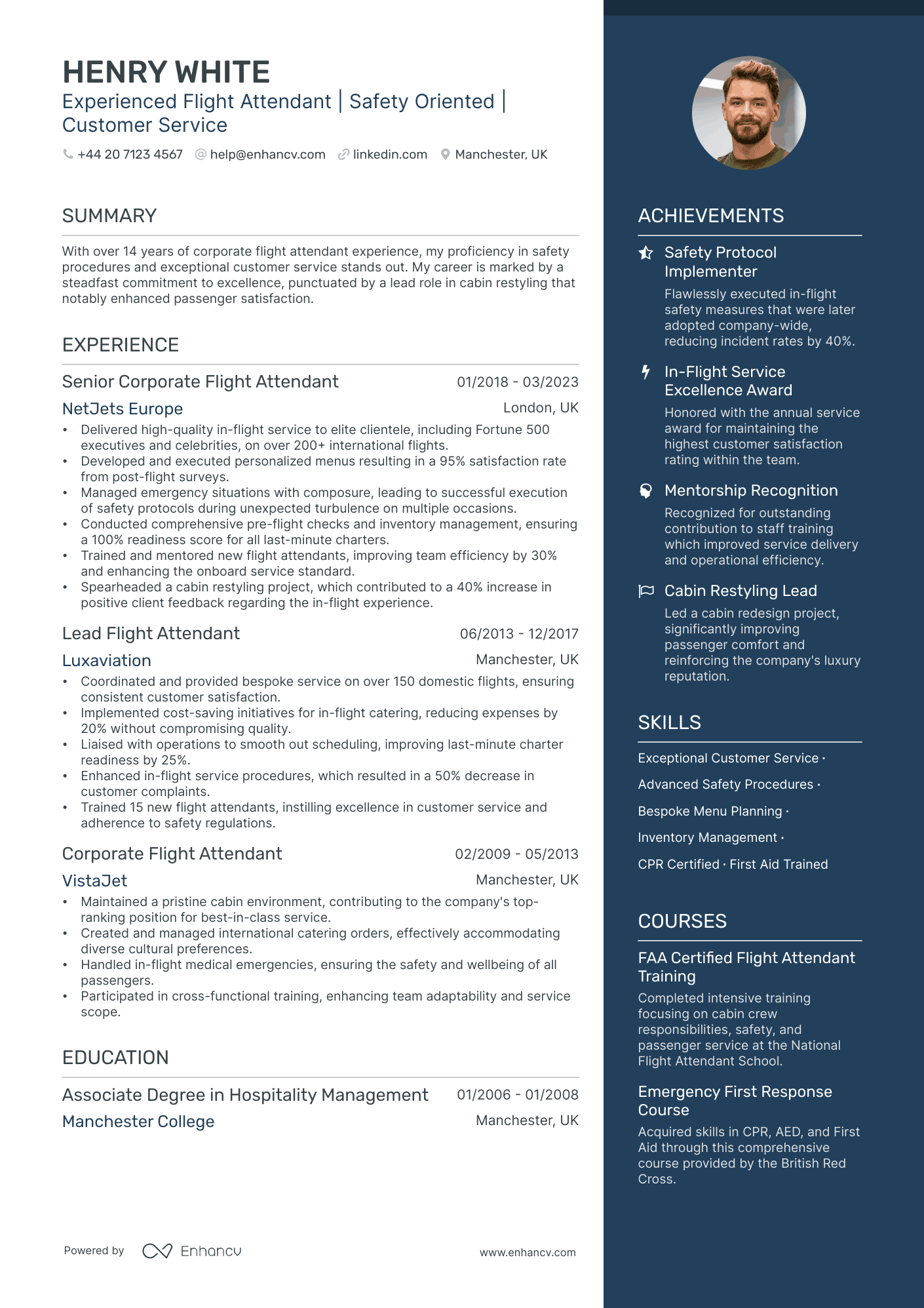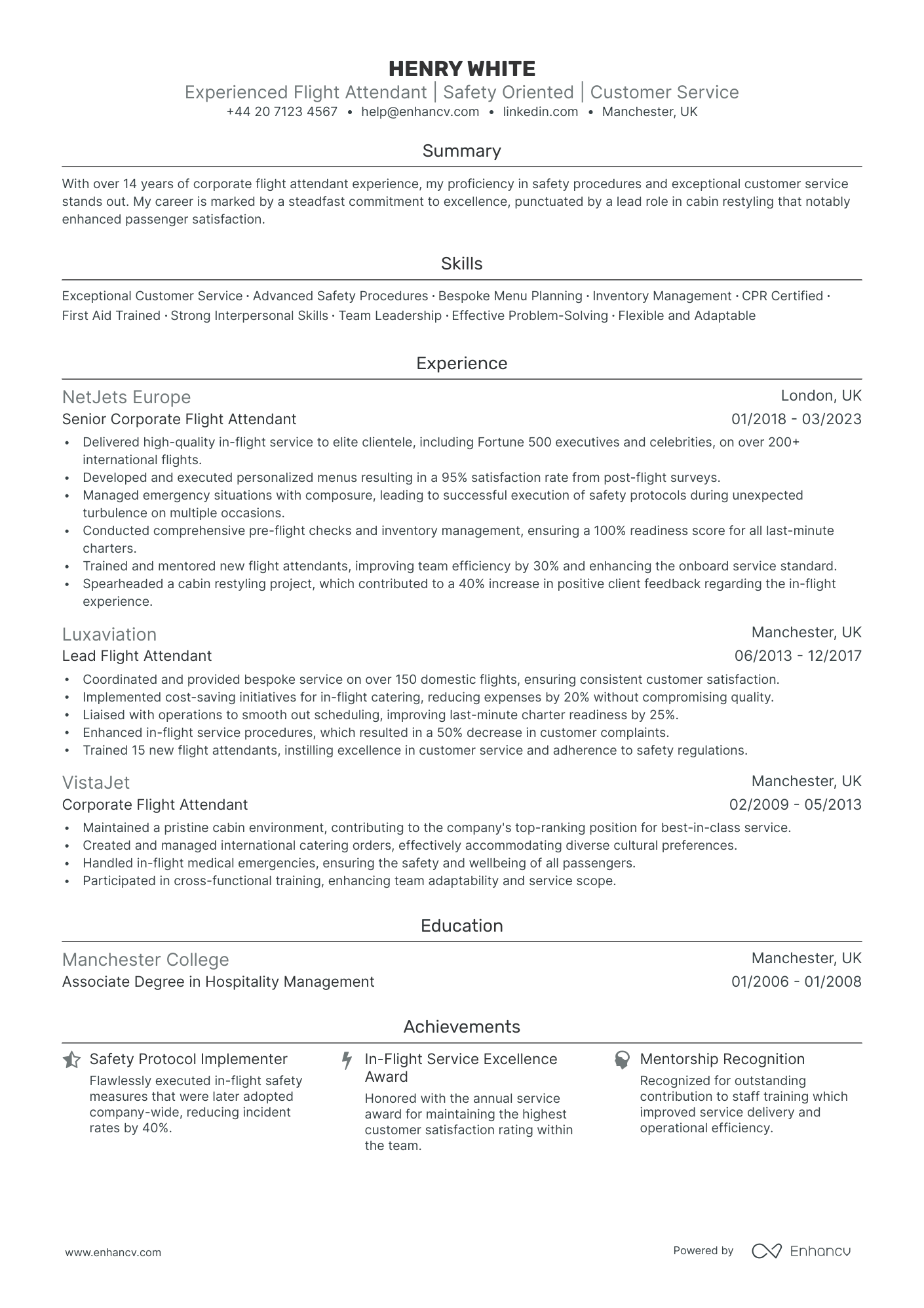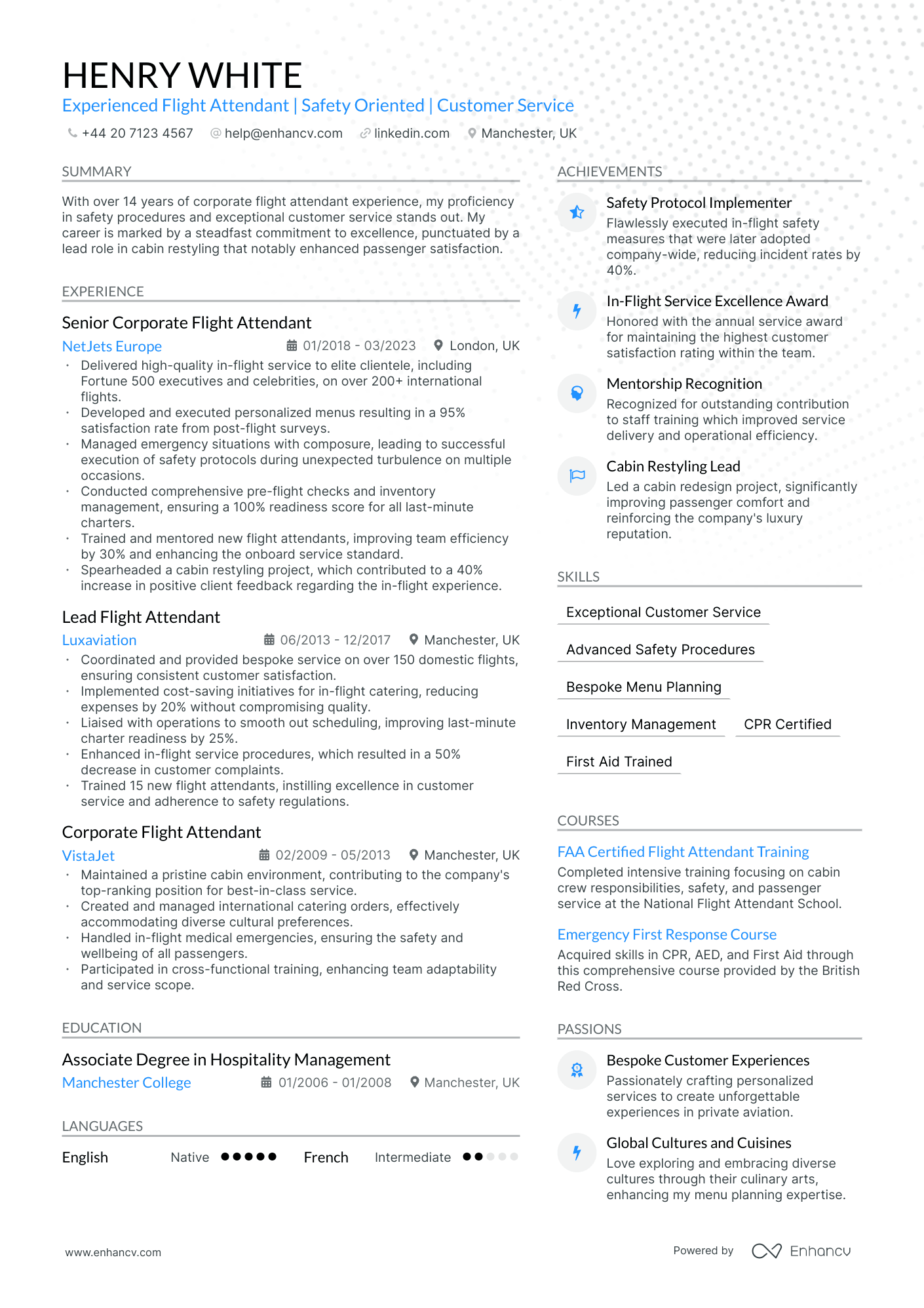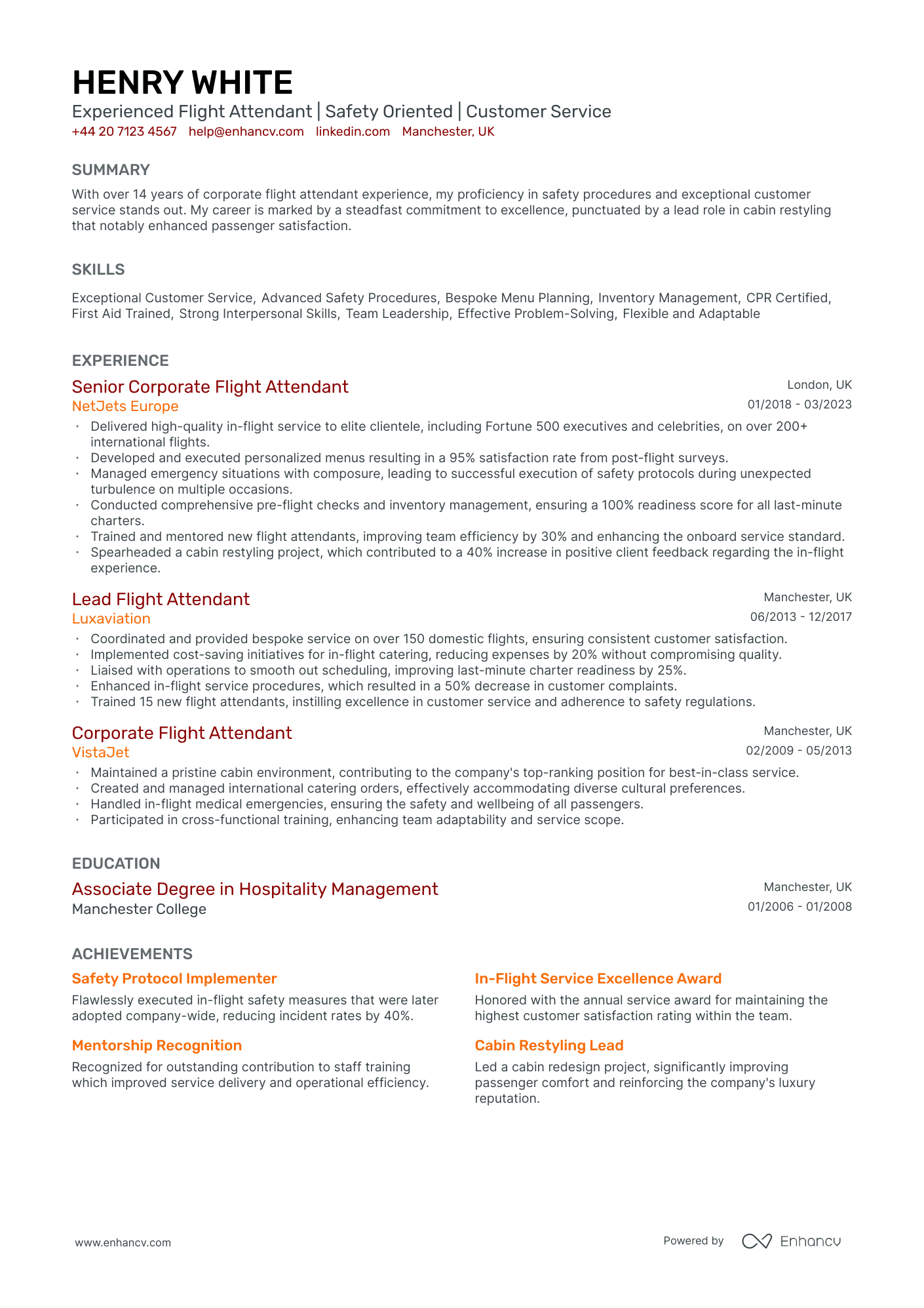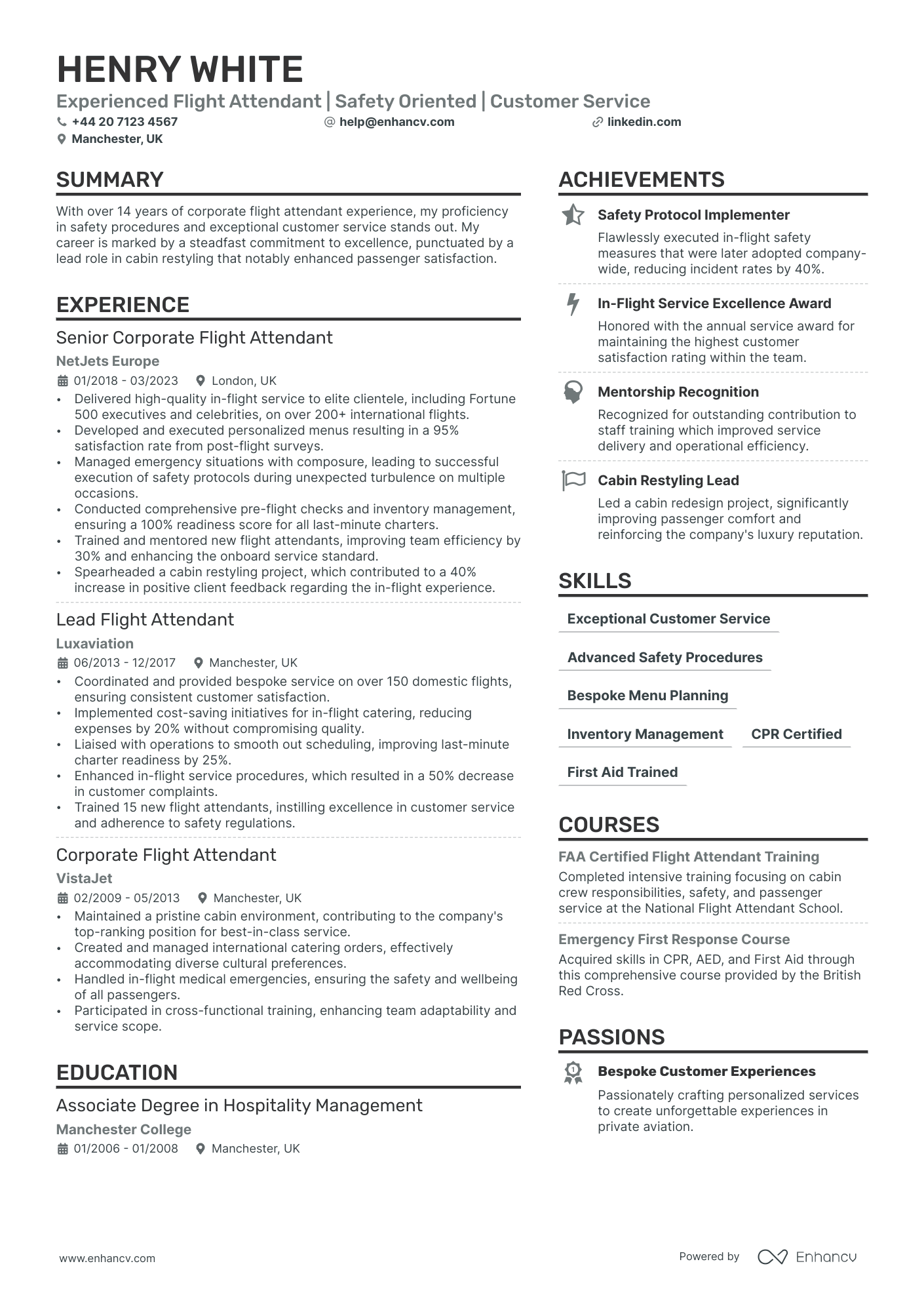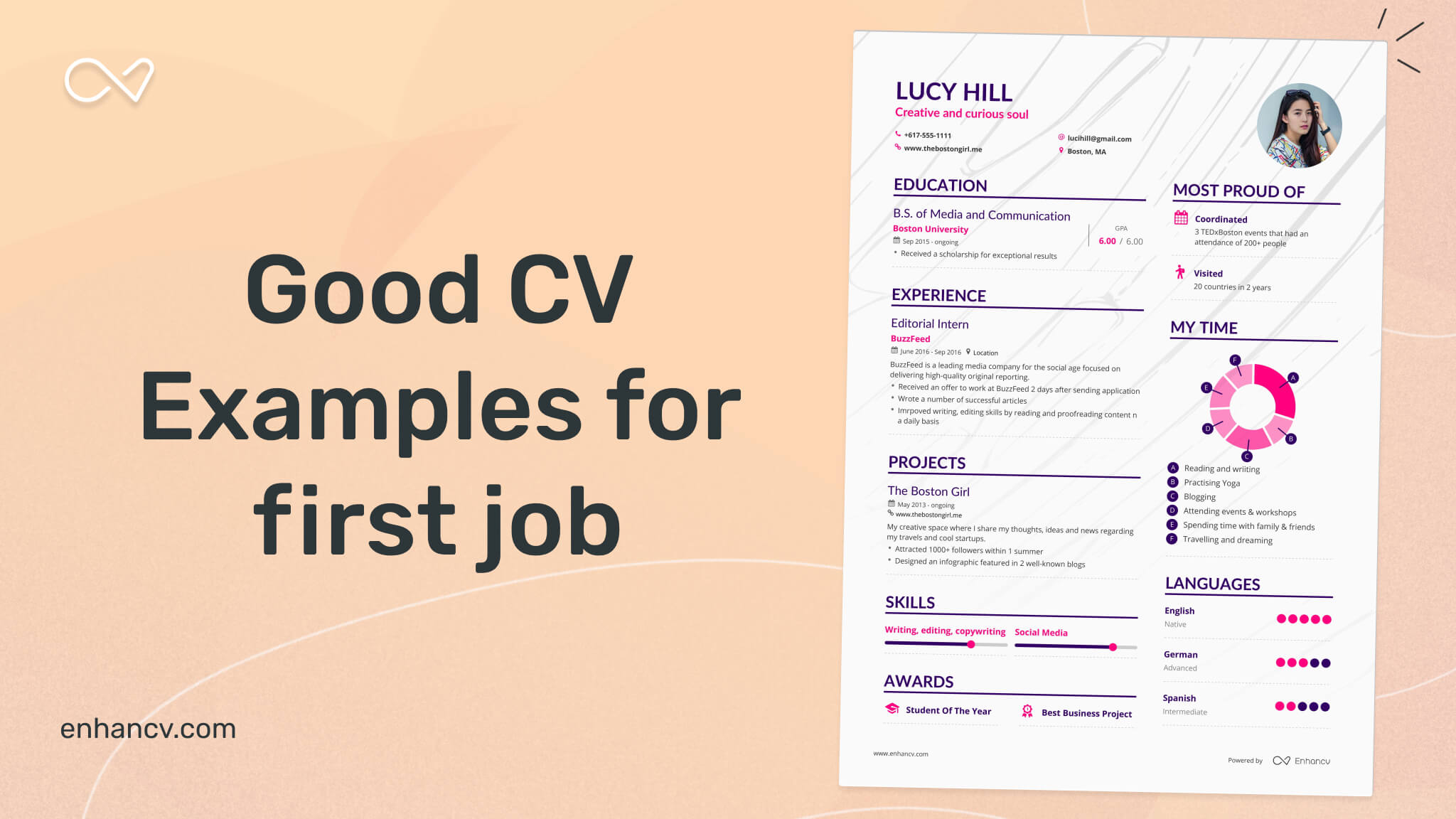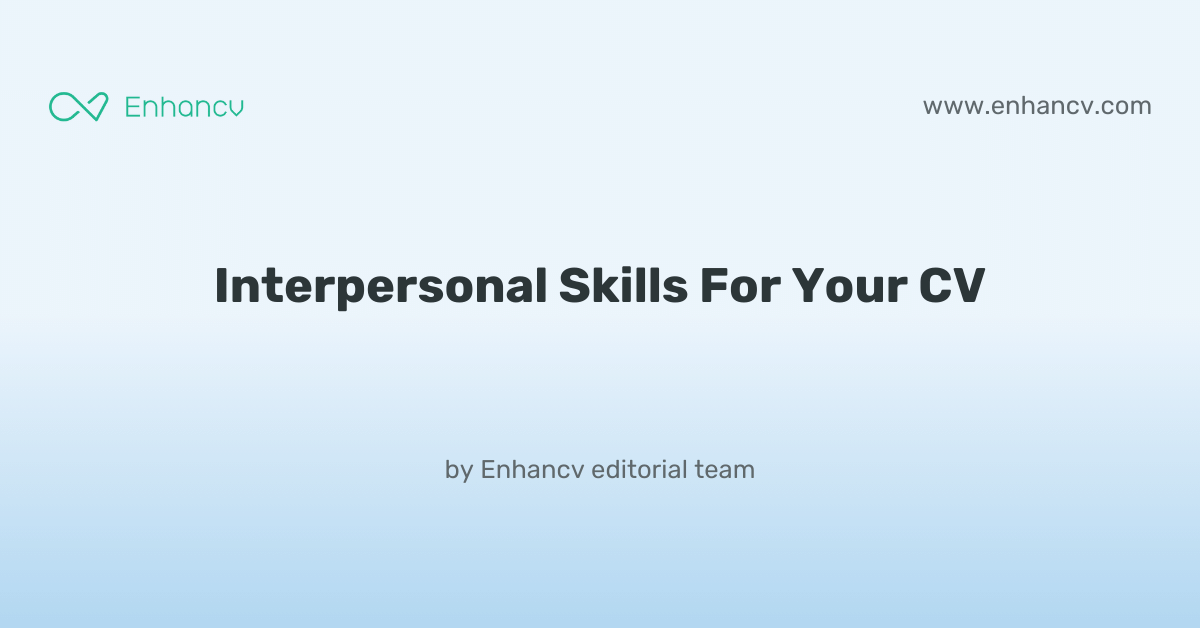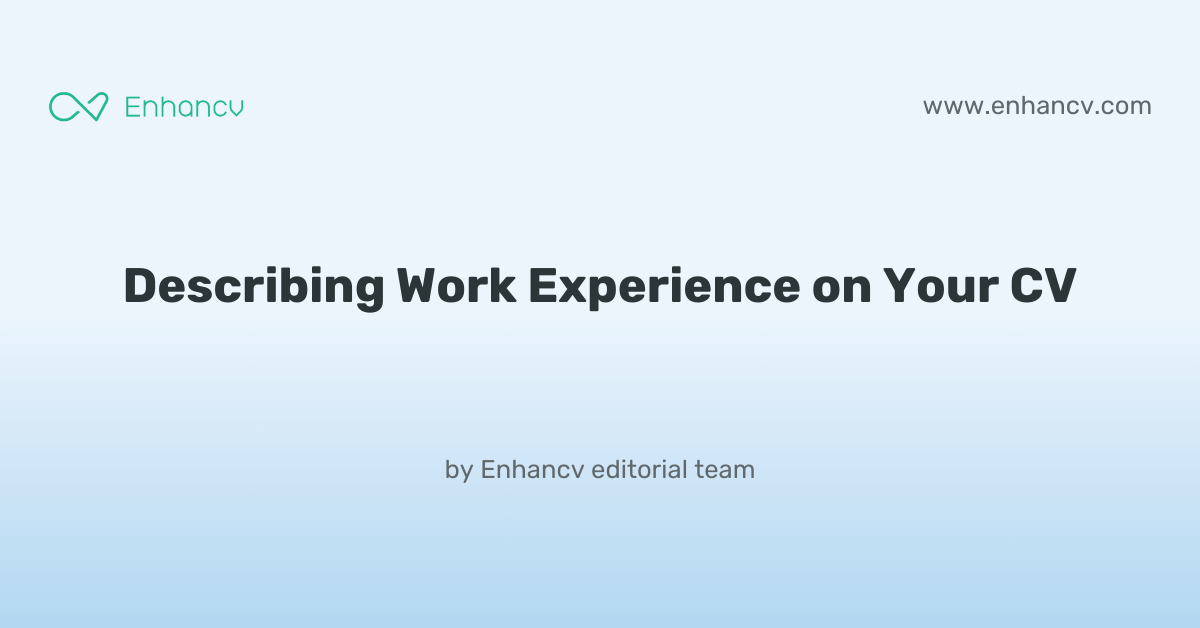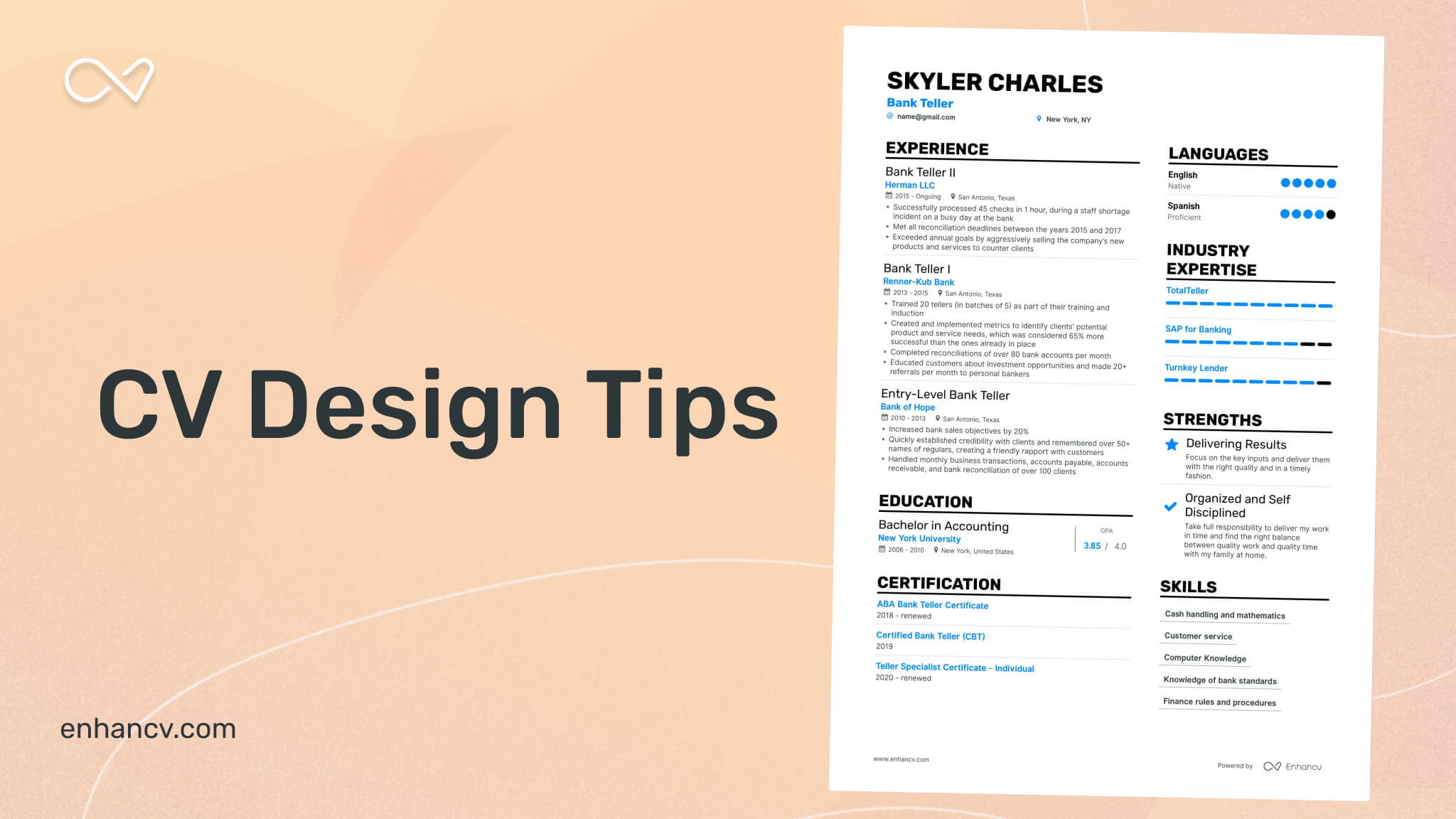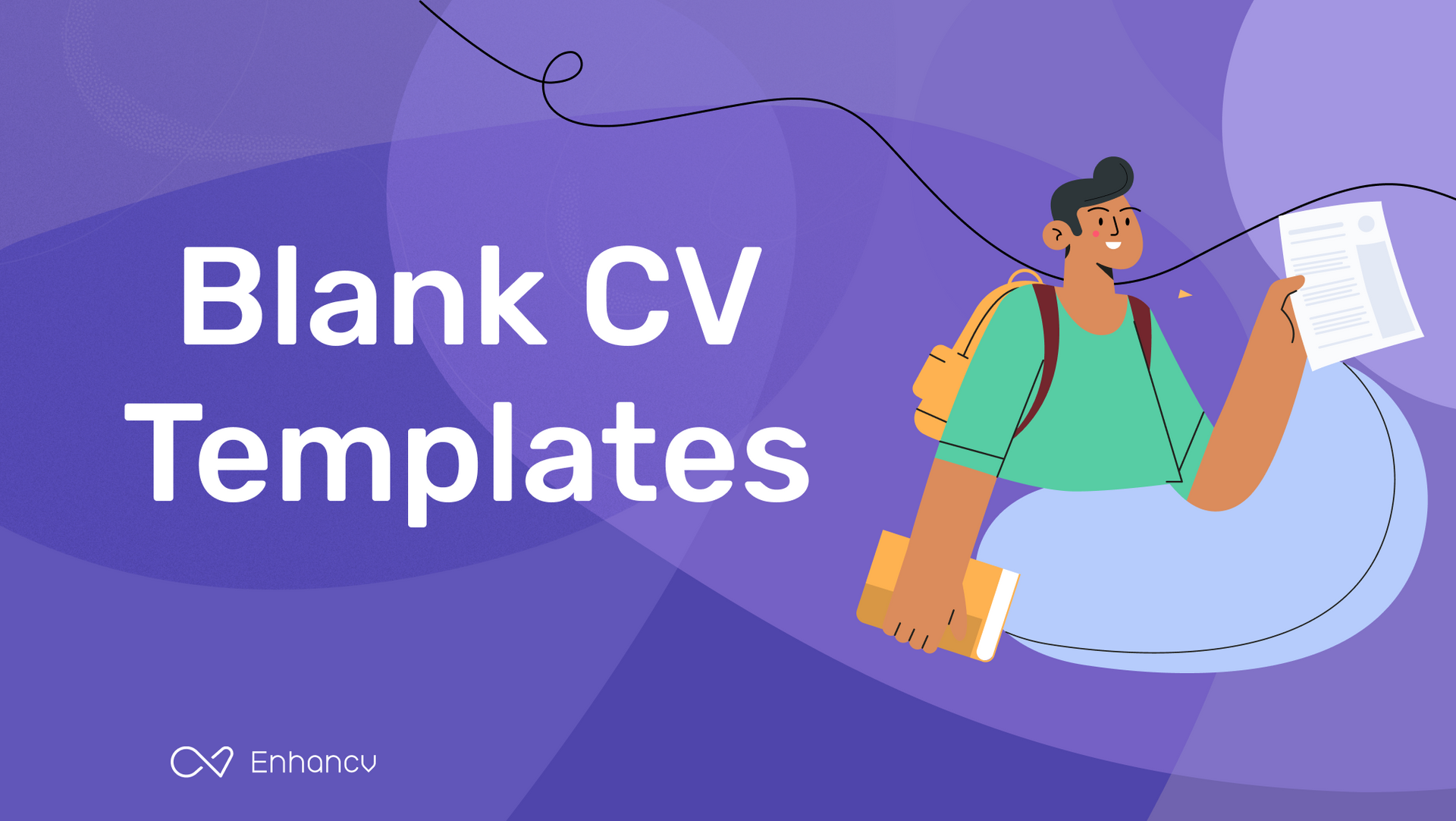Crafting your CV to capture the dynamic and diverse skill set required for a flight attendant role can be a daunting task. Our comprehensive guide offers tailored strategies and examples to help you present your experience and qualifications in a compelling way that stands out to airline recruiters.
- Answer job requirements with your flight attendant CV and experience;
- Curate your academic background and certificates, following industry-leading CV examples;
- Select from +10 niche skills to match the ideal candidate profile
- Write a more succinct experience section that consists of all the right details.
Do you need more specific insights into writing your flight attendant CV? Our guides focus on unique insights for each individual role:
How to ensure your profile stands out with your flight attendant CV format
It's sort of a Catch 22. You want your flight attendant CV to stand out amongst a pile of candidate profiles, yet you don't want it to be too over the top that it's unreadable. Where is the perfect balance between your CV format simple, while using it to shift the focus to what matters most. That is - your expertise. When creating your flight attendant CV:- list your experience in the reverse chronological order - starting with your latest roles;
- include a header with your professional contact information and - optionally - your photograph;
- organise vital and relevant CV sections - e.g. your experience, skills, summary/ objective, education - closer to the top;
- use no more than two pages to illustrate your professional expertise;
- format your information using plenty of white space and standard (2.54 cm) margins, with colours to accent key information.
Once you've completed your information, export your flight attendant CV in PDF, as this format is more likely to stay intact when read by the Applicant Tracker System or the ATS. A few words of advice about the ATS - or the software used to assess your profile:
- Generic fonts, e.g. Arial and Times New Roman, are ATS-compliant, yet many candidates stick with these safe choices. Ensure your CV stands out by using a more modern, and simple, fonts like Lato, Exo 2, Volkhov;
- All serif and sans-serif fonts are ATS-friendly. Avoid the likes of fancy decorative or script typography, as this may render your information to be illegible;
- Both single- and double-column formatted CVs could be assessed by the ATS;
- Integrating simple infographics, icons, and charts across your CV won't hurt your chances during the ATS assessment.
PRO TIP
Incorporate a touch of colour in headers or section breaks, but keep it professional and ensure it doesn’t detract from readability, especially in more conservative industries.
The top sections on a flight attendant CV
- Personal profile details why you are the best candidate.
- Employment history showcases relevant experience.
- Key skills section highlights your cabin crew abilities.
- Education and training indicate qualifications.
- Language proficiency displays valuable communication skills.
What recruiters value on your CV:
- Showcase customer service skills by highlighting any previous roles or experiences where you provided support, care, or service directly to customers, as flight attendant positions greatly value exceptional customer service.
- Detail any language skills you possess, as flight attendants who can communicate in multiple languages are highly sought-after due to the international nature of the role.
- Include any certifications or training relevant to the aviation industry, such as CPR, first aid, or any flight attendant training you've completed, as these qualifications enhance safety onboard.
- Emphasise your ability to remain calm and professional in emergencies or stressful situations, providing examples where you've successfully managed such circumstances.
- Mention your flexibility and willingness to work irregular hours, including nights, weekends, and holidays, as this is a critical requirement for the flight attendant's lifestyle.
Recommended reads:
Tips and tricks on writing a job-winning flight attendant CV header
The CV header is the space which most recruiters would be referring most often to, in the beginning and end of your application. That is as the CV header includes your contact details, but also a headline and a professional photo. When writing your CV header:
- Double-check your contact details for spelling errors or if you've missed any digits. Also, ensure you've provided your personal details, and not your current work email or telephone number;
- Include your location in the form of the city and country you live in. If you want to be more detailed, you can list your full address to show proximity to your potential work place;
- Don't include your CV photo, if you're applying for roles in the UK or US, as this may bias initial recruiters' assessments;
- Write a professional headline that either integrates the job title, some relevant industry keywords, or your most noteworthy achievement.
In the next part of our guide, we'll provide you with professional CVs that showcase some of the best practices when it comes to writing your headline.
Examples of good CV headlines for flight attendant:
- Senior Cabin Crew Member | Certified in First Aid & Safety | Luxury Service Specialist | 8+ Years
- Lead Flight Attendant | Multilingual Communication Expert | Customer Service Excellence | 5 Years’ Experience
- In-Flight Team Leader | Hospitality Management Graduate | International Flight Expertise | 7 Years Onboard
- Experienced Cabin Crew | Aviation Health & Safety | VIP Clientele Management | 4+ Years
- Junior Flight Attendant | Customer Care Prodigy | Pursuing Cabin Safety Certificate | 2 Years Flying
- Cabin Service Supervisor | In-Flight Catering Specialist | Crew Training & Development | 10 Years Aviation
What's the difference between a flight attendant CV summary and objective
Why should it matter to you?
- Your flight attendant CV summary is a showcasing your career ambitions and your unique value. Use the objective to answer why your potential employers should hire you based on goals and ambitions. The objective is the ideal choice for candidates who happen to have less professional experience, but still meet some of the job requirements.
Before you select which one will be more relevant to your experience, have a look at some industry-leading CV summaries and objectives.
CV summaries for a flight attendant job:
- Seasoned flight attendant with over 8 years of experience working for major international airlines, adept at ensuring passenger safety and delivering exceptional in-flight service. Proven record in handling emergency situations with composure, highlighted by a company award for outstanding performance during an unplanned landing incident.
- Dedicated professional with 10 years of experience in customer service management, seeking to transfer strong coordination and communication skills into the aviation sector as a flight attendant. Recognised for enhancing customer satisfaction ratings through attentive service and problem-solving acumen at a leading hospitality company.
- Highly motivated individual seeking to leverage a five-year tenure in the healthcare industry into a successful career as a flight attendant. Committed to bringing top-notch care, critical thinking, and swift decision-making abilities gained from fast-paced clinical settings to ensuring the well-being of airline passengers.
- Meticulous bilingual flight attendant with over 6 years of experience with a renowned regional carrier, committed to implementing safety protocols and providing an enjoyable travel experience. Awarded for my initiative in creating a language assistance program that enhanced communication between crew and non-English speaking passengers.
- Eager to embark on a new career path as a flight attendant, bringing forth a strong desire to contribute to passenger comfort and safety. Committed to achieving the objective of becoming a pivotal member of an airline crew, keen on developing skills required to ensure impeccable service standards and flight operations.
- Aspirant to the flight attendant sector, focused on applying excellent interpersonal skills and a customer-first approach to contribute positively to passenger experiences. Aims to employ hard-won expertise from three years in retail sales to meet the demanding objectives of a fast-paced, service-oriented airline environment.
Narrating the details of your flight attendant CV experience section
Perhaps you've heard it time and time again, but, how you present your experience is what matters the most. Your CV experience section - that details your work history alongside your accomplishments - is the space to spotlight your unqiue expertise and talents. So, avoid solely listing your responsibilities, but instead:
- adverts' keywords and integrate those in your experience section;
- Use your CV to detail how you've been promoted in the past by including experience in the reverse chronological order.
Before you start writing your flight attendant CV experience section, dive into some industry-leading examples on how to structure your bullets.
Best practices for your CV's work experience section
- Maintained a high standard of personal appearance and grooming, consistent with airline regulations, to ensure a professional representation of the company.
- Delivered outstanding customer service, managing and exceeding passenger expectations during flights, enhancing the overall travel experience.
- Conducted pre-flight safety checks and demonstrated emergency procedures, ensuring all passengers were fully informed and prepared.
- Administered first aid to passengers in need, adhering to safety protocols and showing the ability to remain calm and effective under pressure.
- Managed in-flight sales of duty-free merchandise, demonstrating strong sales skills and the ability to meet targets effectively.
- Facilitated communication between the flight deck and passengers, providing timely and accurate information regarding flight details and any changes.
- Managed conflict resolution with passengers diplomatically, ensuring that issues were addressed promptly and satisfactorily.
- Assisted with the boarding process, ensuring it was completed in an orderly and efficient manner while providing special attention to passengers requiring assistance.
- Collaborated effectively with cabin crew and ground staff to ensure adherence to the flight schedule and a seamless travel experience for passengers.
- Managed in-flight services for over 200 international flights, improving passenger satisfaction scores by 18% within the first year.
- Led a team of junior flight attendants, providing mentorship and training that decreased onboard service errors by 25%.
- Conceptualized and implemented a new pre-flight safety demonstration protocol that increased passenger engagement by 30%.
- Performed safety checks and emergency equipment inspections before each flight, maintaining a 100% safety record over four years.
- Facilitated passenger boarding and deplaning processes, cutting average turnaround time by 10 minutes.
- Collaborated with the in-flight entertainment team to curate content, resulting in a 15% increase in passenger usage.
- Addressed and resolved customer service issues in-flight, leading to a 20% reduction in customer complaints.
- Conducted cabin service on over 1500 domestic flights while maintaining compliance with Federal Aviation Regulations.
- Participated in recurrent training programs, achieving an average score of 95% on all safety and service exams.
- Provided exceptional in-flight service to first-class passengers, resulting in a 22% increase in premium cabin repeat customers.
- Assisted pilots with pre-flight preparations and in-flight operations, ensuring adherence to strict industry standards and procedures.
- Collaborated with the catering team to redesign the meal service, which enhanced passenger satisfaction by 12%.
- Executed personalized service techniques that enhanced the travel experience for VIP passengers and frequent flyers.
- Efficiently managed onboard inventory, reducing waste and overstock by 20% through meticulous planning and tracking.
- Coordinated with ground staff to streamline boarding processes, reducing departure delays by an average of 7 minutes per flight.
- Initiated an inter-crew communication system that reduced in-flight misunderstandings and increased team efficiency.
- Delivered in-flight announcements and safety briefings with clarity and poise, enhancing passengers' sense of security.
- Pioneered a cabin cleanliness initiative that led to the airline being recognized for having the cleanest fleet in the industry.
- Regularly selected to represent the airline at trade shows and promotional events due to exceptional service and communication skills.
- Implemented stress reduction activities for passengers during long-haul flights, significantly decreasing air rage incidents by 30%.
- Served as a mentor in the airline's 'Buddy System' for new recruits, improving onboard training efficiency by 20%.
- Orchestrated the revision of in-flight safety manuals to enhance clarity and passenger comprehension, which led to improved safety ratings.
- Efficiently completed biannual emergency response training with a focus on simulated crisis scenarios, ensuring preparedness and rapid response.
- Implemented a customer feedback loop for in-flight services, translating passenger suggestions into actionable improvements.
- Facilitated a language training program for attendants, broadening the team's linguistic capabilities and improving service for international passengers.
- Successfully managed medical emergencies onboard, collaborating with healthcare professionals to ensure passenger safety and wellness.
- Drove the adoption of new technology for in-flight sales which increased revenues by 18% within the electronics and duty-free categories.
- Directed the junior flight attendants' scheduling and shift allocations, optimizing crew utilization and reducing overtime expenses by 15%.
- Participated in focus groups that led to the redesign of cabin uniforms, increasing staff satisfaction and professional appearance.
- Served as the primary liaison between flight crew and passengers during irregular operations, adeptly handling passenger concerns and maintaining calm.
Writing your CV without professional experience for your first job or when switching industries
There comes a day, when applying for a job, you happen to have no relevant experience, whatsoever. Yet, you're keen on putting your name in the hat. What should you do? Candidates who part-time experience , internships, and volunteer work.
Recommended reads:
PRO TIP
Include examples of how you adapted to new tools, environments, or work cultures, showing your flexibility.
Describing your unique skill set using both hard skills and soft skills
Your flight attendant CV provides you with the perfect opportunity to spotlight your talents, and at the same time - to pass any form of assessment. Focusing on your skill set across different CV sections is the way to go, as this would provide you with an opportunity to quantify your achievements and successes. There's one common, very simple mistake, which candidates tend to make at this stage. Short on time, they tend to hurry and mess up the spelling of some of the key technologies, skills, and keywords. Copy and paste the particular skill directly from the job requirement to your CV to pass the Applicant Tracker System (ATS) assessment. Now, your CV skills are divided into:
- Technical or hard skills, describing your comfort level with technologies (software and hardware). List your aptitude by curating your certifications, on the work success in the experience section, and technical projects. Use the dedicated skills section to provide recruiters with up to twelve technologies, that match the job requirements, and you're capable of using.
- People or soft skills provide you with an excellent background to communicate, work within a team, solve problems. Don't just copy-paste that you're a "leader" or excel at "analysis". Instead, provide tangible metrics that define your success inusing the particular skill within the strengths, achievements, summary/ objective sections.
Top skills for your flight attendant CV:
Safety Procedures Knowledge
Emergency Response Training
First Aid and CPR Certified
Customer Service
In-Flight Service Execution
Aircraft Systems Understanding
Multilingualism
Passenger Safety Briefing
Food and Beverage Handling
Ticketing and Reservation Systems
Communication
Teamwork
Patience
Flexibility
Interpersonal Skills
Problem-Solving
Attention to Detail
Time Management
Dependability
Cultural Sensitivity
PRO TIP
Order your skills based on the relevance to the role you're applying for, ensuring the most pertinent skills catch the employer's attention first.
CV education and certificates: your academic background as proof of your skill set
A common misconception about your flight attendant CV education is that you only need it, if you have less professional experience. That is completely false. The CV education section serves to back up your technical (and sometimes personal) capabilities, fill in gaps in your work history, and show you have the initial industry background and know-how. When creating your education section:
- List your degrees in the reverse chronological order, starting with the most recent (and relevant) ones first;
- Include your degree and university names, start and graduation dates. It's optional to also denote you received a "First-Class Honours" for diplomas that are more relevant to the role;
- Curate your relevant university coursework, projects, or thesis work if you happen to have less professional expertise and need to integrate more job keywords and skills.
Your professional qualifications don't need to stop at your academic background. It's advisable to also select up to three of your most noteworthy (and relevant) industry certificates and feature them in a dedicated section. Once more, include the certificate name, the institution that issued it out, and the date you obtained it on. You could feature both hard skills and soft skills certificates, as in the examples below:
PRO TIP
If you have received professional endorsements or recommendations for certain skills, especially on platforms like LinkedIn, mention these to add credibility.
Recommended reads:
Key takeaways
Impressing recruiters with your experience, skill set, and values starts with your professional flight attendant CV. Write concisely and always aim to answer job requirements with what you've achieved; furthermore:
- Select a simple design that complements your experience and ensures your profile is presentable;
- Include an opening statement that either spotlights your key achievements (summary) or showcases your career ambitions (objective);
- Curate your experience bullets, so that each one commences with a strong, action verb and is followed up by your skill and accomplishment;
- List your hard and soft skills all across different sections of your CV to ensure your application meets the requirements;
- Dedicate space to your relevant higher education diplomas and your certificates to show recruiters you have the necessary industry background.
